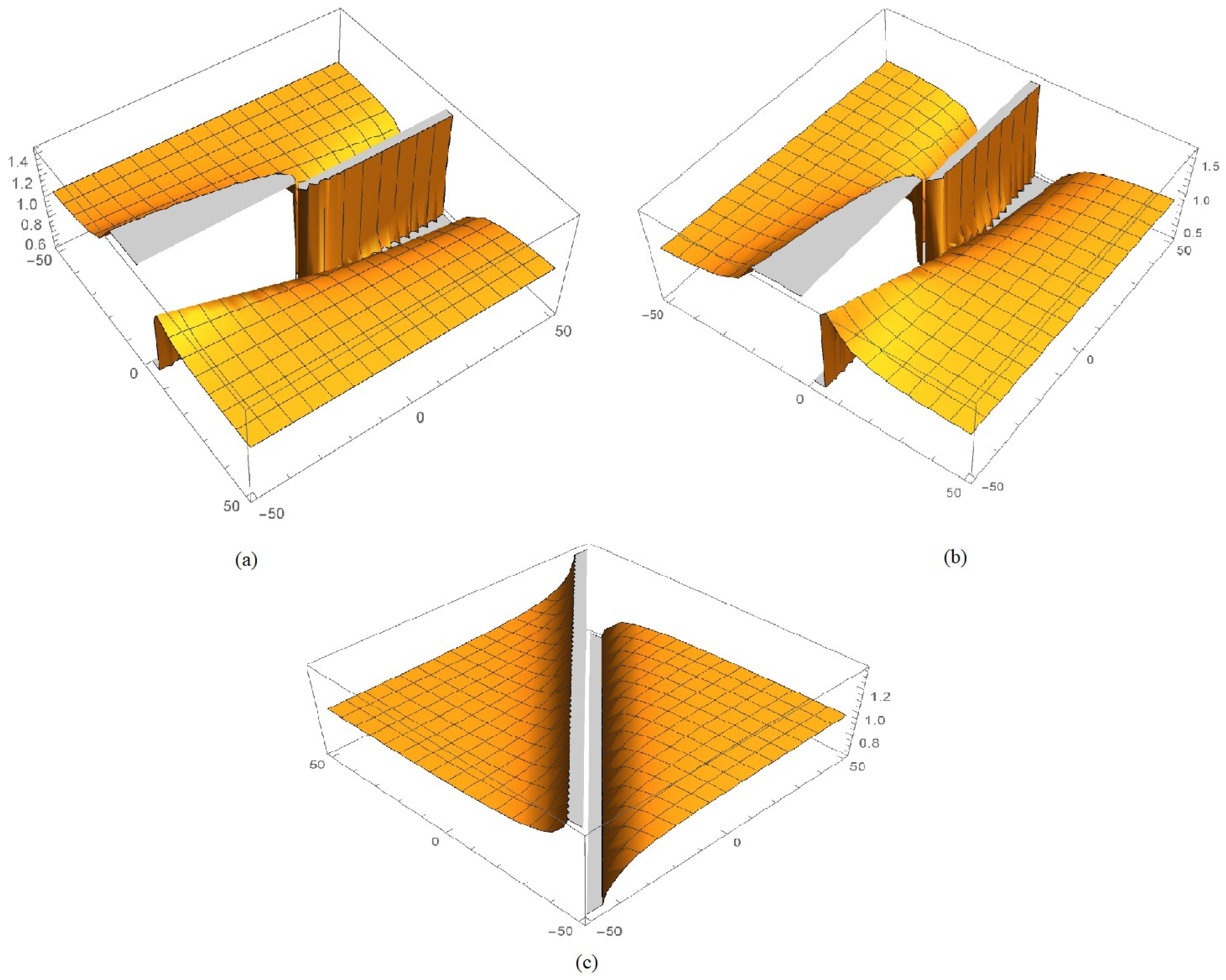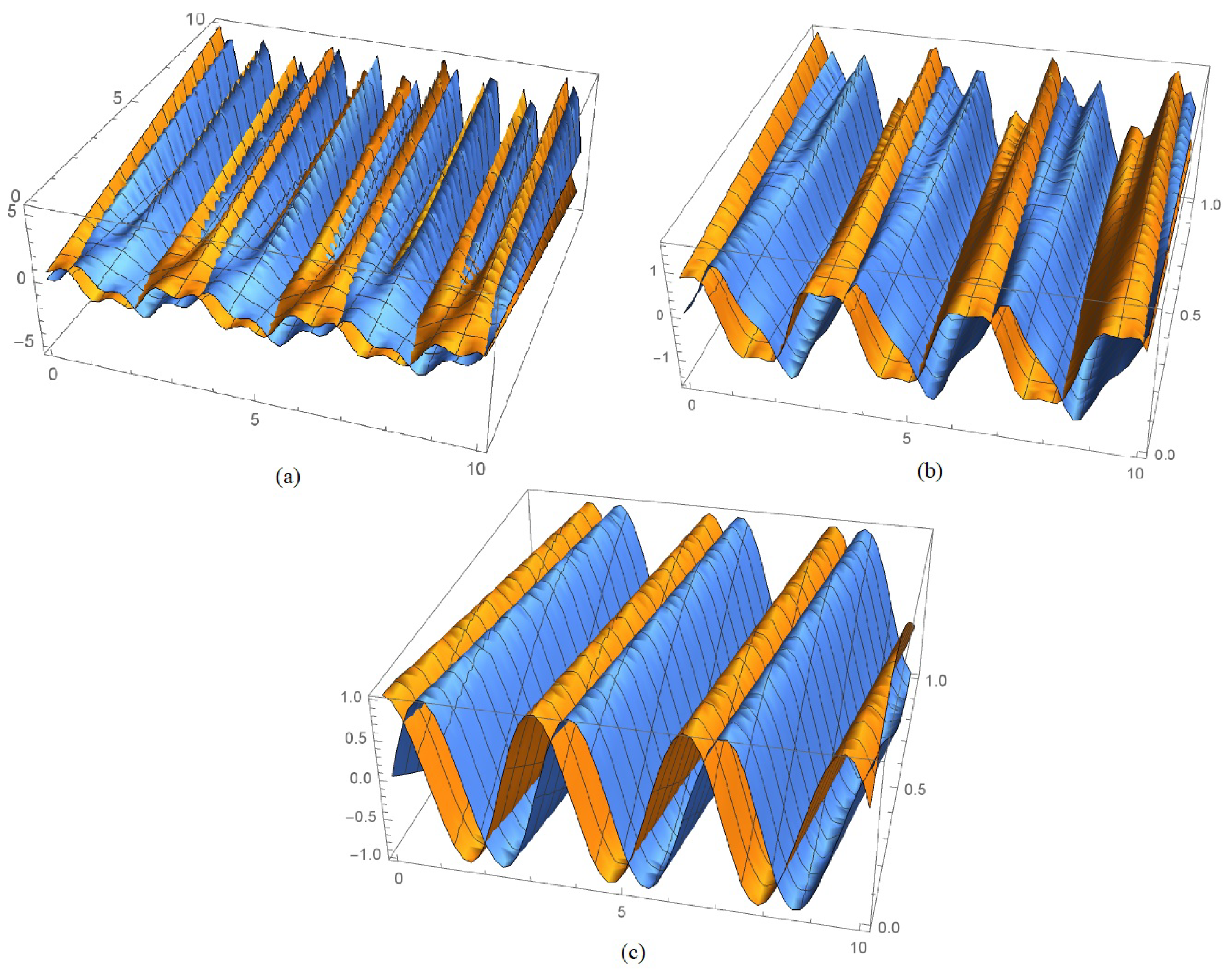Stability Analysis and Computational Interpretation of an Effective Semi Analytical Scheme for Fractional Order Non-Linear Partial Differential Equations
Abstract
:1. Introduction and Preliminaries
- or
2. Basis of the Laplace Variational Iteration Method
3. Stability Analysis of the Laplace Variational Iteration Scheme
4. Applications of Laplace Variational Iteration (LVI) Scheme on Various FODEs Types
5. Discussion and Conclusions
- The calculation of Adomian polynomials in the Adomian decomposition method is not an easy task;
- In the variational iteration method, Lagrange’s multiplier is very difficult to calculate;
- Similarly, the calculation of He’s polynomials in homotopy analysis as well as in the homotopy perturbation method is a time consuming task.
Author Contributions
Funding
Data Availability Statement
Acknowledgments
Conflicts of Interest
References
- De Jager, E.M. On the origin of the Korteweg–de Vries equation. arXiv 2006, arXiv:math/0602661. [Google Scholar]
- Grunert, K.; Teschl, G. Long-time asymptotics for the Korteweg–de Vries equation via nonlinear steepest descent. Math. Phys. Anal. Geom. 2009, 12, 287–324. [Google Scholar] [CrossRef] [Green Version]
- Halliday, D.; Resnick, R.; Merrill, J. Fundamentals of Physics; Wiley: New York, NY, USA, 1981; Volume 9. [Google Scholar]
- Hicdurmaz, B. Finite difference schemes for time-fractional Schrödinger equations via fractional linear multistep method. Int. J. Comput. Math. 2021, 98, 1561–1573. [Google Scholar] [CrossRef]
- Serway, R.A.; Moses, C.J.; Moyer, C.A. Modern Physics; Cengage Learning: Boston, MA, USA, 2004. [Google Scholar]
- Lin, J.; Xu, Y.; Zhang, Y. Simulation of linear and nonlinear advection–diffusion–reaction problems by a novel localized scheme. Appl. Math. Lett. 2020, 99, 106005. [Google Scholar] [CrossRef]
- Saleh, R.; Mabrouk, S.M.; Wazwaz, A.M. The singular manifold method for a class of fractional-order diffusion equations. Waves Random Complex Media 2021, 1–12. [Google Scholar] [CrossRef]
- Akram, T.; Abbas, M.; Riaz, M.B.; Ismail, A.I.; Ali, N.M. An efficient numerical technique for solving time fractional Burgers equation. Alex. Eng. J. 2020, 59, 2201–2220. [Google Scholar] [CrossRef]
- Lodhi, S.; Manzar, M.A.; Raja, M.A.Z. Fractional neural network models for nonlinear Riccati systems. Neural Comput. Appl. 2019, 31, 359–378. [Google Scholar] [CrossRef]
- Vijayakumar, V.; Ravichandran, C.; Nisar, K.S.; Kucche, K.D. New discussion on approximate controllability results for fractional Sobolev type Volterra-Fredholm integro-differential systems of order 1 < r < 2. Numer. Methods Partial Differ. Equ. 2021, 1–19. [Google Scholar] [CrossRef]
- Hietarinta, J. Introduction to the Hirota bilinear method. In Integrability of Nonlinear Systems; Springer: Berlin/Heidelberg, Germany, 1997; pp. 95–103. [Google Scholar]
- Zhang, Z.; Li, B.; Chen, J.; Guo, Q. Construction of higher-order smooth positons and breather positons via Hirota’s bilinear method. Nonlinear Dyn. 2021, 105, 2611–2618. [Google Scholar] [CrossRef]
- Davies, B. Integral Transforms and Their Applications; Springer: Berlin/Heidelberg, Germany, 2012; Volume 41. [Google Scholar]
- Podlubny, I. The Laplace transform method for linear differential equations of the fractional order. arXiv 2006, arXiv:functan/9710005. [Google Scholar]
- Anjum, N.; He, J.H. Laplace transform: Making the variational iteration method easier. Appl. Math. Lett. 2019, 92, 134–138. [Google Scholar] [CrossRef]
- He, J.H. Variational iteration method-a kind of non-linear analytical technique: Some examples. Int. J. Nonlinear Mech. 1999, 34, 699–708. [Google Scholar] [CrossRef]
- Wazwaz, A.M. Partial Differential Equations and Solitary Waves Theory; Springer: Berlin/Heidelberg, Germany, 2010. [Google Scholar]
- Gil, A.; Segura, J.; Temme, N.M. Numerical Methods for Special Functions; Cambridge University Press: Cambridge, UK, 2007; Volume 99. [Google Scholar]
- Kanwal, A.; Phang, C.; Loh, J.R. New collocation scheme for solving fractional partial differential equations. Hacet. J. Math. Stat. 2020, 49, 1107–1125. [Google Scholar] [CrossRef] [Green Version]
- Khader, M.M.; Saad, K.M.; Hammouch, Z.; Baleanu, D. A spectral collocation method for solving fractional KdV and KdV-Burgers equations with non-singular kernel derivatives. Appl. Numer. Math. 2021, 161, 137–146. [Google Scholar] [CrossRef]
- Loh, J.R.; Isah, A.; Phang, C.; Toh, Y.T. On the new properties of Caputo-Fabrizio operator and its application in deriving shifted Legendre operational matrix. Appl. Numer. Math. 2018, 132, 138–153. [Google Scholar] [CrossRef]
- Yavuz, M.; Sulaiman, T.A.; Usta, F.; Bulut, H. Analysis and numerical computations of the fractional regularized long-wave equation with damping term. Math. Methods Appl. Sci. 2021, 44, 7538–7555. [Google Scholar] [CrossRef]
- Arshad, M.S.; Iqbal, J. Semi-Analytical Solutions of Time-Fractional KdV and Modified KdV Equations. Sci. Inq. Rev. 2019, 3, 47–59. [Google Scholar] [CrossRef]
- Arshad, S.; Sohail, A.; Maqbool, K. Nonlinear shallow water waves: A fractional order approach. Alex. Eng. J. 2016, 55, 525–532. [Google Scholar] [CrossRef] [Green Version]
- Iqbal, J.; Shabbir, K.; Guran, L. Semianalytical Solutions of Some Nonlinear-Time Fractional Models Using Variational Iteration Laplace Transform Method. J. Funct. Spaces 2021, 2021, 8345682. [Google Scholar] [CrossRef]
- Karakoc, S.B.G.; Ali, K.K. Theoretical and computational structures on solitary wave solutions of Benjamin Bona Mahony-Burgers equation. Tbil. Math. J. 2021, 14, 33–50. [Google Scholar] [CrossRef]
- Yavuz, M.; Sulaiman, T.A.; Yusuf, A.; Abdeljawad, T. The Schrödinger-KdV equation of fractional order with Mittag-Leffler nonsingular kernel. Alex. Eng. J. 2021, 60, 2715–2724. [Google Scholar] [CrossRef]
- Zhang, J.; Wang, J.; Zhou, Y. Numerical analysis for time-fractional Schrödinger equation on two space dimensions. Adv. Differ. Equ. 2020, 53, 1–16. [Google Scholar] [CrossRef] [PubMed] [Green Version]
- Caputo, M.; Fabrizio, M. On the singular kernels for fractional derivatives. Some applications to partial differential equations. Progr. Fract. Differ. Appl. 2021, 7, 1–4. [Google Scholar]
- Caputo, M.; Fabrizio, M. A new definition of fractional derivative without singular kernel. Progr. Fract. Differ. Appl. 2015, 1, 1–13. [Google Scholar]
- Ain, Q.T.; Anjum, N.; Din, A.; Zeb, A.; Djilali, S.; Khan, Z.A. On the analysis of Caputo fractional order dynamics of Middle East Lungs Coronavirus (MERS-CoV) model. Alex. Eng. J. 2022, 61, 5123–5131. [Google Scholar] [CrossRef]
- Dong, Y.; Tang, X.; Yuan, Y. Principled reward shaping for reinforcement learning via Lyapunov stability theory. Neurocomputing 2020, 393, 83–90. [Google Scholar] [CrossRef]
- Li, L.; Chen, W. Exponential stability analysis of quaternion-valued neural networks with proportional delays and linear threshold neurons: Continuous-time and discrete-time cases. Neurocomputing 2020, 381, 152–166. [Google Scholar] [CrossRef]
- Yang, X.; Li, C.; Huang, T.; Song, Q. Mittag-Leffler stability analysis of nonlinear fractional-order systems with impulses. Appl. Math. Comput. 2017, 293, 416–422. [Google Scholar] [CrossRef]
- Ali, A.; Mahariq, I.; Shah, K.; Abdeljawad, T.; Al-Sheikh, B. Stability analysis of initial value problem of pantograph-type implicit fractional differential equations with impulsive conditions. Adv. Differ. Equ. 2021, 1, 1–17. [Google Scholar] [CrossRef]
- Kreyszig, E. Introductory Functional Analysis with Applications; John Wiley Sons: Hoboken, NJ, USA, 1991; Volume 17. [Google Scholar]





Publisher’s Note: MDPI stays neutral with regard to jurisdictional claims in published maps and institutional affiliations. |
© 2022 by the authors. Licensee MDPI, Basel, Switzerland. This article is an open access article distributed under the terms and conditions of the Creative Commons Attribution (CC BY) license (https://creativecommons.org/licenses/by/4.0/).
Share and Cite
Iqbal, J.; Shabbir, K.; Guran, L. Stability Analysis and Computational Interpretation of an Effective Semi Analytical Scheme for Fractional Order Non-Linear Partial Differential Equations. Fractal Fract. 2022, 6, 393. https://doi.org/10.3390/fractalfract6070393
Iqbal J, Shabbir K, Guran L. Stability Analysis and Computational Interpretation of an Effective Semi Analytical Scheme for Fractional Order Non-Linear Partial Differential Equations. Fractal and Fractional. 2022; 6(7):393. https://doi.org/10.3390/fractalfract6070393
Chicago/Turabian StyleIqbal, Javed, Khurram Shabbir, and Liliana Guran. 2022. "Stability Analysis and Computational Interpretation of an Effective Semi Analytical Scheme for Fractional Order Non-Linear Partial Differential Equations" Fractal and Fractional 6, no. 7: 393. https://doi.org/10.3390/fractalfract6070393
APA StyleIqbal, J., Shabbir, K., & Guran, L. (2022). Stability Analysis and Computational Interpretation of an Effective Semi Analytical Scheme for Fractional Order Non-Linear Partial Differential Equations. Fractal and Fractional, 6(7), 393. https://doi.org/10.3390/fractalfract6070393







